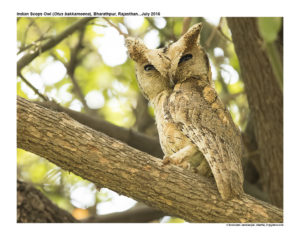
Indian Scops Owl Otus bakkamoena
Etymology:
- Otus : Latin word for eared Owl
- Bakkamoena: Sinhlala name for Owl
Vernacular Names :Mar: Kantheri Shingla Ghubad
Distribution in India: Wide spread resident below Himalayas in India
Description: Size of 20–22 cm; wt. of 25–152 g, male wingspan is 60·5–61 cm, female wingspan is 66 cm. It is a medium-sized Scops owl. It occurs in grey-brown and rufous morphs. It has a light greyish or rufous with prominent black border facial disc. The forehead, eyebrows and conspicuous long ear-tufts are much paler and whitish, with crown that is mottled blackish. The upperparts are mottled and spotted dark, with distinct buffy collar on hindneck and another on nape, but indistinct scapular spots. The underparts are grey-buff to rufous-buff, with dark shaft streaks and vermiculation. The Irides are hazel-brown to dark brown, bill is greenish horn-brown, cere is dusky green, toes are brownish-flesh to greenish-yellow, legs and feet may be feathered to base of toes. Juvenile are pale grey to yellowish-brown, barred brown all over.
Habitat: It is found in forest, second-growth woodland, groves near towns and in cultivated areas, well-timbered gardens, and orchards with shade trees. It is found from plains 2400 m.
Food habits: It eats primarily invertebrates such as beetles, grasshoppers and other insects, including moth larvae; also mammals like rodents and bats, small birds and lizards.It is nocturnal, roosts in hollows or dense tree foliage during day.
Breeding habits: They breed in Dec–May in India. The nest is a natural hollow in tree trunk. They lay a clutch of 3–5 eggs. The incubation period is 25–27 days.